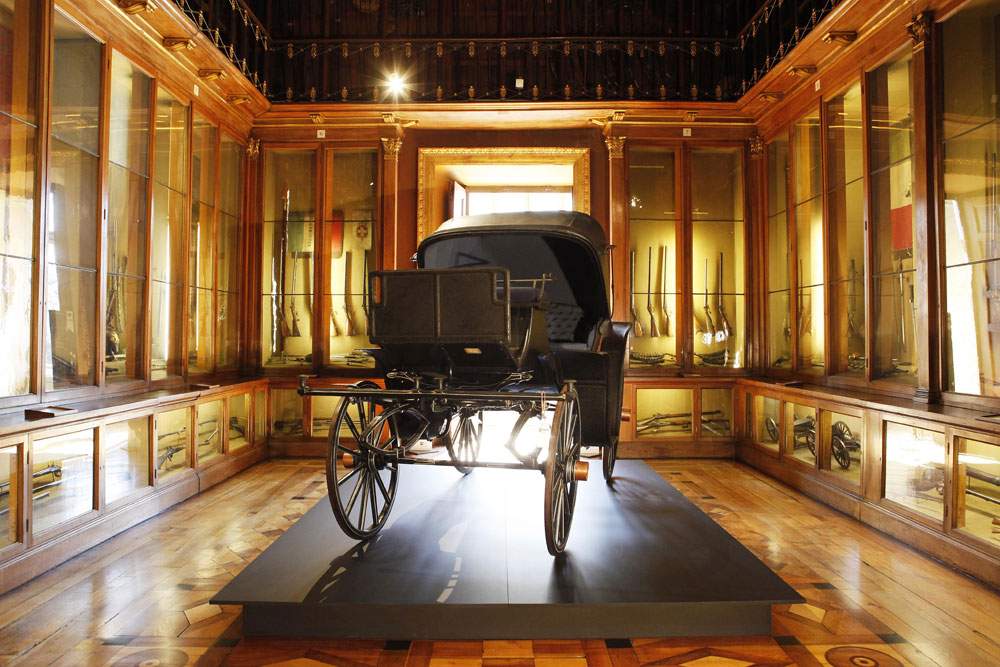160th anniversary of the Unification of Italy: new layout for the Royal Museums of Turin
As of March 17, on the occasion of the 160th anniversary of the Unification of Italy, the Royal Museums of Turin, although it is not possible to visit them for the time being due to closures for anti-Covid restrictive measures, present a new exhibit. Specifically, in the Rotunda of the Royal Armory, comes the carriage of Victor Emmanuel II, the first king of Italy from 1861 to 1878 and whose 200th birth anniversary was celebrated in 2020.
The carriage will be placed a few steps from the loggia from which Charles Albert announced the promulgation of the Statute on March 4, 1848. Belonging to the Quirinal Presidential Collections, the carriage named Mylord, remembered in inventories by the ancient definition of ’Polonese’ or ’Polacca,’ was one of the king’s favorite means of transportation, which he used on his private outings to Rome. It is a low, open model with no doors, four wheels and two seats with a driving box for the coachman, made by the Roman firm of Casalini brothers. Today the carriage is part of the oldest and most valuable core of the Presidential Collection.
Also presented is the new display The King’s Arms: a selection of twenty-one recently restored objects of considerable value and historical importance that belonged to Victor Emmanuel II’s rich personal collections. In addition to arms, the collection includes flags, uniforms, honors, and other strictly personal items, including diplomatic gifts or weapons commemorating the battles of the Risorgimento, or others related to the king’s personal interests, especially hunting, documented by a rich collection of rifles and knives.
The new display also includes two Japanese suits of armor, B. 53 and B. 54, both donated to the sovereign by Emperor Meiji in 1869 and 1871, just a few years after the signing of the Treaty of Friendship and Trade that initiated diplomatic relations between the Kingdom of Italy and the Japanese Empire. Prestigious gifts that testify to the care taken in making them and the choice of materials used. The first armor is a light defensive apparatus used for foot combat. Unlike B. 53, which was mounted as early as the 19th century on a dummy, B. 54 armor has only now been re-presented as a whole to emphasize its unified appearance and facilitate a more immediate reading. The two suits of armor, with the extra-European collections, were set up in the Rotunda of the Royal Armory, a room in which Victor Emmanuel II’s collections were also housed.
The Royal Armory currently holds over five thousand pieces.
“The collection of the Royal Armory of Turin occupies a distinguished place in the European context, but its valorization is neither easy nor taken for granted, given the highly historicized layout of the spaces and the nineteenth-century imprint that distinguishes its first arrangement,” stresses Enrica Pagella, director of the Royal Museums. “I therefore express my sincere thanks to the Presidency of the Republic for this loan, which will constitute an unprecedented element of attraction and lightness in the severe circuit of the Palagiana showcases, while also contributing to strengthening the symbolic link between our current capital and the Royal Palace of Turin, the first seat of the House of Savoy and the place where the nation’s first constitutional charter took shape.”
"The new exhibition The King’s Arms aims to enhance a nucleus of little-known but particularly important objects, both from a historical point of view and for their value,“ says Giorgio Careddu, curator of the Royal Armory’s art collections. ”The sabers and swords, mostly for representation, were offered to the king as a sign of gratitude for his role in the historical process that led to the unification of Italy. The firearms, on the other hand, are in most cases hunting doublets made by Filippo Panataro, Vittorio Emanuele II’s personal armorer, and by the most important European manufacturers of the time."
 |
| 160th anniversary of the Unification of Italy: new layout for the Royal Museums of Turin |
Warning: the translation into English of the original Italian article was created using automatic tools. We undertake to review all articles, but we do not guarantee the total absence of inaccuracies in the translation due to the program. You can find the original by clicking on the ITA button. If you find any mistake,please contact us.





























